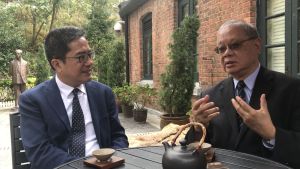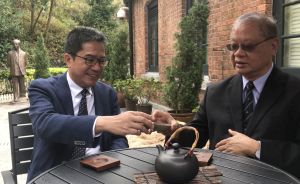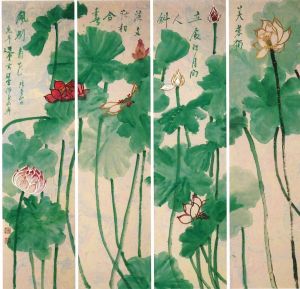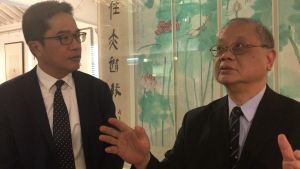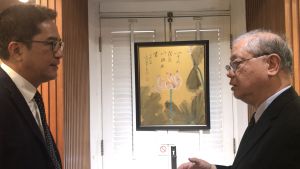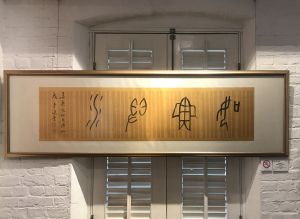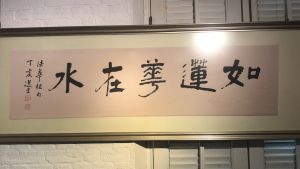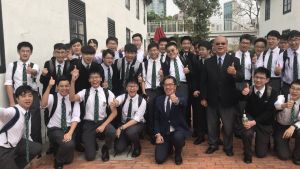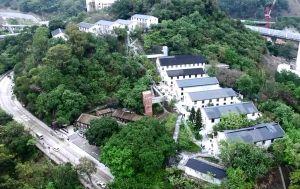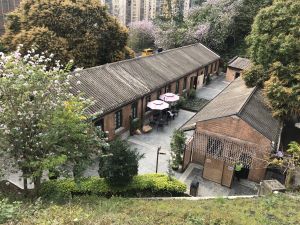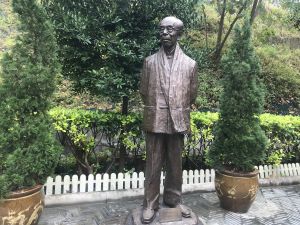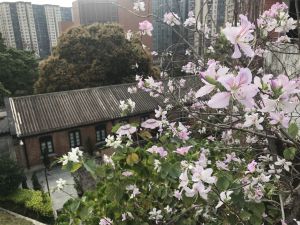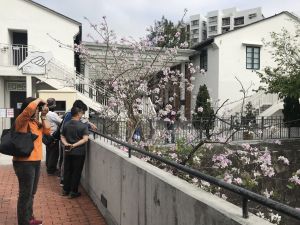Jao Tsung-I Academy – Professor Lee Chack-fan’s recollection of Professor Jao
|
Distinguished sinologist Professor Jao Tsung-I passed away last month at the old age of 101. Professor Jao was very learned in matters of the ancient and modern worlds, and equally if not more talented in both the academic field and fine arts. His remarkable achievements in academia and arts and his contributions towards promoting traditional Chinese culture have won our deepest respect. Today I meet up with the Director of Jao Tsung-I Petite Ecole of The University of Hong Kong, Professor Lee Chack-fan, at the Jao Tsung-I Academy, an historic building revitalisation project. We pay tribute to Professor Jao and look at some of the Academy’s precious collection. The Jao Tsung-I Academy is located on a hillside in Lai Chi Kok. The compound was previously the Former Lai Chi Kok Hospital. Professor Lee is the Chairman of the Management Committee of the Academy. He told me that the compound has a history stretching back to more than 100 years. In the past, it was once used as a customs station for the Qing government, lodgings for Chinese labourers, a quarantine station, a prison, a hospital for infectious diseases and a psychiatric rehabilitation centre. The compound has witnessed the historic and social changes over the years. The Jao Tsung-I Academy is one of the revitalisation projects under the first batch of the “Revitalising Historic Buildings Through Partnership Scheme” launched by the Development Bureau in 2008. It is named in honour of Professor Jao with an aim of passing on our cultural heritage and has become a platform for promoting Chinese culture. Lotus flower paintings revered in art circles Professor Jao liked painting lotus flowers with his works on lotus flowers displaying infinite variety. The Academy has collected the “Four-screen Lotus Set” which was painted specially by Professor Jao for the Academy. This work, which has been called the “Treasure of the Academy”, is made up of four screens of paintings combined together with each screen about two metres in height. The work can be displayed as four paintings or combined together as one painting. The four-character couplets, with the meaning of “one departs from this life leaving nothing behind, so take things as they come while still living this life”, on both sides of the work, also written by Professor Jao, come from the Mawangdui Silk Texts. Professor Lee explained that each of the eight lotus flowers in the painting has its own beautiful pose. Some lotus flowers have a touch of red within the white while some are sketched out using gold lines. For this work, Professor Jao had the Dunhuang Murals in mind when coming up with an artistic style to use. In the painting, the leaves are painted using the splashing ink style so as to create an artistic feel of elegance. Professor Lee said one of the reasons Professor Jao liked painting lotus flowers so much was that lotus flowers are known as the “Gentleman Among Flowers”, with straight branches supporting the flowers and leaves. This represents a spirit of embracing responsibility which is deeply thought provoking. One and only “Jao form” The Academy also displays several pieces of precious calligraphy of Professor Jao. The calligraphy has a unique style and is unusually graceful, whether it is the brush technique, use of ink, style of characters, etc. Professor Lee pointed out that Professor Jao was obsessed with calligraphy for many years. Familiar with the calligraphy of each ancient period, he was able to write out many forms of script, including the tablet inscriptions of the Northern Dynasties, clerical script, seal script, semi-cursive script and cursive script. There wasn’t one style that Professor Jao did not know about and he was extremely well read. Professor Jao also created calligraphy in the style of oracle bone script and fused together different types of scripts to create a unique calligraphy that has been hailed as “Jao style”. The calligraphy work “Like A Lotus In The Water” that the Academy displays, is in the “Jao style”. The writing has traces of clerical script and of the Northern Dynasties tablet inscriptions. In addition, Professor Jao could wield Mao Long brushes for both calligraphy and painting, for all styles in between. Professor Lee said Mao Long brushes are slightly larger in size with a solid body and is formidable when used for calligraphy. Attentiveness and diligence, life-long learning As a close friend for many years, Professor Lee remembers that Professor Jao had many areas that are worth learning from for the younger generation. For example, for more than 80 years, he was diligent and attentive, was not easily distracted, and frequently worked till late. Administrative matters or chores would not hinder Professor Jao. Generally speaking, a university professor, for example a college-level professor would write several hundred academic theses over a career. However, Professor Jao had over a thousand theses and over one hundred published works. Such an achievement was entirely the result of personal diligence and attentiveness. Professor Jao was involved in many academic fields. This may perhaps be attributed to his constant self-study, life-long learning and courageous spirit for exploring new things. A sea of flowers surrounded by green The Jao Tsung-I Academy, located on a hillside in Lai Chi Kok, is divided into three zones, namely the lower, middle and upper zones. The Gallery in the Lower Zone, which I introduce earlier, houses the permanent exhibition of Professor Jao’s works of art. Another two exhibition halls are used to hold thematic exhibitions on a regular basis. The Heritage Hall mainly displays the evolving history of the compound during the past 100 years or so and the process of its heritage preservation-cum-revitalisation. To facilitate the organising of different cultural and creative activities, cultural exchange, education programmes and cultural tourism, etc., there are six blocks of houses in the middle zone, providing such facilities as a theatre, exhibition halls, a lecture hall, a conference room, activity rooms and a café as well as a restaurant. The venues are suitable for various organisations for holding meetings and different kinds of activities, such as workshops, talks, retreats and arts performances, etc. The Heritage Lodge, located in the upper zone, offers 89 comfortable guest rooms and a unique accommodation experience for guests. On the day of our visit, the hillside was covered with a sea of flowers (Bauhinia variegata) and surrounded by green trees. It attracted a lot of visitors to come and take photos. Apart from the Gallery, Professor Lee and I also visited an exhibition called “The Vivid World of Chinese Characters: From the Origin to the Future” which provided us with cultural experience of the vitality of Chinese characters. During our visit, we met dozens of secondary school students who are Professor Lee’s junior schoolmates. I am glad to see that the students could leave their classrooms to study and hope that they have a different kind of learning experience at the Academy. The Academy hosts different cultural and art activities from time to time, which attracted over 250 000 attendees last year. I hope the Jao Tsung-I Academy can become a good place for Hong Kong people to relax and enrich their cultural life. |
|
11 March, 2018
Back